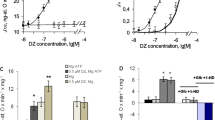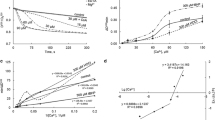Abstract
It is known that a closure of ATP sensitive (mitoKATP) or BK-type Ca2+ activated (mitoKCa) potassium channels triggers opening of the mitochondrial permeability transition pore (MPTP) in cells and isolated mitochondria. We found earlier that the Tl+-induced MPTP opening in Ca2+-loaded rat liver mitochondria was accompanied by a decrease of 2,4-dinitrophenol-uncoupled respiration and increase of mitochondrial swelling and ΔΨmito dissipation in the medium containing TlNO3 and KNO3. On the other hand, our study showed that the mitoKATP inhibitor, 5-hydroxydecanoate favored the Tl+-induced MPTP opening in the inner membrane of Ca2+-loaded rat heart mitochondria (Korotkov et al. 2013). Here we showed that 5-hydroxydecanoate increased the Tl+-induced MPTP opening in the membrane of rat liver mitochondria regardless of the presence of mitoKATP modulators (diazoxide and pinacidil). This manifested in more pronounced decrease in the uncoupled respiration and acceleration of both the swelling and the ΔΨmito dissipation in isolated rat liver mitochondria, incubated in the medium containing TlNO3, KNO3, and Ca2+. A slight delay in Ca2+-induced swelling of the mitochondria exposed to diazoxide could be result of an inhibition of succinate oxidation by the mitoKATP modulator. Mitochondrial calcium retention capacity (CRC) was markedly decreased in the presence of the mitoKATP inhibitor (5-hydroxydecanoate) or the mitoKCa inhibitor (paxilline). We suggest that the closure of mitoKATP or mitoKCa in calcium loaded mitochondria favors opening of the Tl+-induced MPTP in the inner mitochondrial membrane.







Similar content being viewed by others

References
Ardehali H, O’Rourke B (2005) Mitochondrial KATP channels in cell survival and death. J Mol Cell Cardiol 39(1):7–16
Bednarczyk P, Barker GD, Halestrap AP (2008) Determination of the rate of K+ movement through potassium channels in isolated rat heart and liver mitochondria. Biochim Biophys Acta 1777(6):540–548
Bradford MM (1976) A rapid and sensitive method for the quantitation of microgram quantities of protein utilizing the principle of protein-dye binding. Anal Biochem 72:248–254
Brierley GP, Jurkowitz M, Scott KM, Merola AJ (1970) Ion transport by heart mitochondria. XX. Factors affecting passive osmotic swelling of isolated mitochondria. J Biol Chem 245(20):5404–5411
Cheng Y, Gu XQ, Bednarczyk P, Wiedemann FR, Haddad GG, Siemen D (2008) Hypoxia increases activity of the BK-channel in the inner mitochondrial membrane and reduces activity of the permeability transition pore. Cell Physiol Biochem 22(1–4):127–136
Cheng Y, Debska-Vielhaber G, Siemen D (2010) Interaction of mitochondrial potassium channels with the permeability transition pore. FEBS Lett 584(10):2005–2012
Costa AD, Quinlan CL, Andrukhiv A, West IC, Jabůrek M, Garlid KD (2006a) The direct physiological effects of mitoKATP opening on heart mitochondria. Am J Physiol Heart Circ Physiol 290(1):H406–H415
Costa AD, Jakob R, Costa CL, Andrukhiv K, West IC, Garlid KD (2006b) The mechanism by which the mitochondrial ATP-sensitive K+ channel opening and H2O2 inhibit the mitochondrial permeability transition. J Biol Chem 281(30):20801–20808
Crestanello JA, Doliba NM, Babsky AM, Doliba NM, Niibori K, Osbakken MD, Whitman GJ (2000) Opening of potassium channels protects mitochondrial function from calcium overload. J Surg Res 94(2):116–123
Dahlem YA, Wolf G, Siemen D, Horn TF (2006) Combined modulation of the mitochondrial ATP-dependent potassium channel and the permeability transition pore causes prolongation of the biphasic calcium dynamics. Cell Calcium 39(5):387–400
Das M, Parker JE, Halestrap AP (2003) Matrix volume measurements challenge the existence of diazoxide/glibencamide-sensitive KATP channels in rat mitochondria. J Physiol 547(Pt 3):893–902
Douglas KT, Bunni MA, Baindur SR (1990) Thallium in biochemistry. Int J Biochem 22(5):429–438
Foster DB, Ho AS, Rucker J, Garlid AO, Chen L, Sidor A, Garlid KD, O’Rourke B (2012) Mitochondrial ROMK channel is a molecular component of mitoKATP. Circ Res 111(4):446–454
Garlid KD, Halestrap AP (2012) The mitochondrial KATP channel-fact or fiction? J Mol Cell Cardiol 52(3):578–583
Halestrap AP (2009) What is the mitochondrial permeability transition pore? J Mol Cell Cardiol 46(6):821–831
Halestrap AP, Clarke SJ, Khaliulin I (2007) The role of mitochondria in protection of the heart by preconditioning. Biochim Biophys Acta 1767(8):1007–1031
Hausenloy DJ, Yellon DM, Mani-Babu S, Duchen MR (2004) Preconditioning protects by inhibiting the mitochondrial permeability transition. Am J Physiol Heart Circ Physiol 287(2):H841–H849
Heinen A, Camara AK, Aldakkak M, Rhodes SS, Riess ML, Stowe DF (2007a) Mitochondrial Ca2+-induced K+ influx increases respiration and enhances ROS production while maintaining membrane potential. Am J Physiol Cell Physiol 292(1):C148–C156
Heinen A, Aldakkak M, Stowe DF, Rhodes SS, Riess ML, Varadarajan SG, Camara AK (2007b) Reverse electron flow-induced ROS production is attenuated by activation of mitochondrial Ca2+-sensitive K+ channels. Am J Physiol Heart Circ Physiol 293(3):H1400–H1407
Heinen A, Winning A, Schlack W, Hollmann MW, Preckel B, Frässdorf J, Weber NC (2008) The regulation of mitochondrial respiration by opening of mKCa channels is age-dependent. Eur J Pharmacol 578(2-3):108–113
Hogeboom GH, Schneider WC, Palade GH (1948) Cytochemical studies of mammalian tissues. I. Isolation of intact mitochondria from rat liver; some biological properties of mitochondria and submicroscopic particulate material. J Biol Chem 172(2):619–635
Holmuhamedov EL, Jahangir A, Oberlin A, Komarov A, Colombini M, Terzic A (2004) Potassium channel openers are uncoupling protonophores: implication in cardioprotection. FEBS Lett 568(1–3):167–170
Ichas F, Mazat JP (1998) From calcium signaling to cell death: two conformations for the mitochondrial permeability transition pore. Switching from low- to high-conductance state. Biochim Biophys Acta 1366(1–2):33–50
Jabůrek M, Yarov-Yarovoy V, Paucek P, Garlid KD (1998) State-dependent inhibition of the mitochondrial KATP channel by glyburide and 5-hydroxydecanoate. J Biol Chem 273(22):13578–13582
Kopustinskiene DM, Jovaisiene J, Liobikas J, Toleikis A (2002) Diazoxide and pinacidil uncouple pyruvate-malate-induced mitochondrial respiration. J Bioenerg Biomembr 34(1):49–53
Kopustinskiene DM, Toleikis A, Saris NE (2003) Adenine nucleotide translocase mediates the K(ATP)-channel-openers-induced proton and potassium flux to the mitochondrial matrix. J Bioenerg Biomembr 35(2):141–148
Korge P, Honda HM, Weiss JN (2002) Protection of cardiac mitochondria by diazoxide and protein kinase C: implications for ischemic preconditioning. Proc Natl Acad Sci U S A 99(5):3312–3317
Korotkov SM (2009) Effects of Tl+ on ion permeability, membrane potential and respiration of isolated rat liver mitochondria. J Bioenerg Biomembr 41(3):277–287
Korotkov SM (2013) Thallium, effects on mitochondria. In: Kretsinger RH, Uversky VN, Permyakov EA (eds) Encyclopedia of metalloproteins. Springer, New York, pp 2193–2202
Korotkov SM, Saris NE (2011) Influence of Tl+ on mitochondrial permeability transition pore in Ca2+-loaded rat liver mitochondria. J Bioenerg Biomembr 43(2):149–162
Korotkov SM, Nesterov VP, Ryabchikov NN (2006) Study of the mechanism of action of diazoxide on rat heart mitochondria under calcium loading. Dokl Biochem Biophys 408:133–137
Korotkov SM, Glazunov VV, Yagodina OV (2007) Increase in the toxic effects of Tl+ on isolated rat liver mitochondria in the presence of nonactin. J Biochem Mol Toxicol 21(2):81–91
Korotkov SM, Emel’yanova LV, Brailovskaya IV, Nesterov VP (2012) Effects of pinacidil and calcium on isolated rat heart mitochondria. Dokl Biochem Biophys 443:113–117
Korotkov SM, Nesterov VP, Brailovskaya IV, Furaev VV, Novozhilov AV (2013) Tl+ induces both cationic and transition pore permeability in the inner membrane of rat heart mitochondria. J Bioenerg Biomembr 45(6):531–539
Kupsch K, Parvez S, Siemen D, Wolf G (2007) Modulation of the permeability transition pore by inhibition of the mitochondrial KATP channel in liver vs brain mitochondria. J Membr Biol 215(2–3):69–74
Lim KH, Javadov SA, Das M, Clarke SJ, Suleiman MS, Halestrap AP (2002) The effects of ischaemic preconditioning, diazoxide and 5-hydroxydecanoate on rat heart mitochondrial volume and respiration. J Physiol 545(Pt 3):961–974
Melnick RL, Monti LG, Motzkin SM (1976) Uncoupling of mitochondrial oxidative phosphorylation by thallium. Biochem Biophys Res Commun 69(1):68–73
Mio Y, Uezono S, Kitahata H (2014) Anesthetic cardioprotection in relation to mitochondria: basic science. Curr Pharm Des 20(36):5673–5680
Nikitina ER, Glazunov VV (2003) Involvement of K+-ATP-dependent channel in transport of monovalent thallium (Tl+) across the inner membrane of rat liver mitochondria. Dokl Biochem Biophys 392:244–246
Nishida H, Matsumoto A, Tomono N, Hanakai T, Harada S, Nakaya H (2010) Biochemistry and physiology of mitochondrial ion channels involved in cardioprotection. FEBS Lett 584(10):2161–2166
Nowikovsky K, Schweyen RJ, Bernardi P (2009) Pathophysiology of mitochondrial volume homeostasis: potassium transport and permeability transition. Biochim Biophys Acta 1787(5):345–350
Nuñez IP, Fantinelli J, Arbeláez LF, Mosca SM (2011) Mitochondrial KATP channels participate in the limitation of infarct size by cariporide. Naunyn Schmiedeberg’s Arch Pharmacol 383(6):563–571
Pasdois P, Beauvoit B, Costa AD, Vinassa B, Tariosse L, Bonoron-Adèle S, Garlid KD, Dos Santos P (2007) Sarcoplasmic ATP-sensitive potassium channel blocker HMR1098 protects the ischemic heart: implication of calcium, complex I, reactive oxygen species and mitochondrial ATP-sensitive potassium channel. J Mol Cell Cardiol 42(3):631–642
Portenhauser R, Schäfer G, Trolp R (1971) Inhibition of mitochondrial metabolism by the diabetogenic thiadiazine diazoxide. II. Interaction with energy conservation and ion transport. Biochem Pharmacol 20(10):2623–2632
Pourahmad J, Eskandari MR, Daraei B (2010) A comparison of hepatocyte cytotoxic mechanisms for thallium (I) and thallium (III). Environ Toxicol 25(5):456–467
Queliconi BB, Wojtovich AP, Nadtochiy SM, Kowaltowski AJ, Brookes PS (2011) Redox regulation of the mitochondrial KATP channel in cardioprotection. Biochim Biophys Acta 1813(7):1309–1315
Riess ML, Camara AK, Heinen A, Eells JT, Henry MM, Stowe DF (2008) KATP channel openers have opposite effects on mitochondrial respiration under different energetic conditions. J Cardiovasc Pharmacol 51(5):483–491
Rousou AJ, Ericsson M, Federman M, Levitsky S, McCully JD (2004) Opening of mitochondrial KATP channels enhances cardioprotection through the modulation of mitochondrial matrix volume, calcium accumulation, and respiration. Am J Physiol Heart Circ Physiol 287(5):H1967–H1976
Saris NE, Skulskii IA, Savina MV, Glasunov VV (1981) Mechanism of mitochondrial transport of thallous ions. J Bioenerg Biomembr 13(1–2):51–59
Sato T, Saito T, Saegusa N, Nakaya H (2005) Mitochondrial Ca2+-activated K+ channels in cardiac myocytes: a mechanism of the cardioprotective effect and modulation by protein kinase A. Circulation 111(2):198–203
Szabò I, Leanza L, Gulbins E, Zoratti M (2012) Physiology of potassium channels in the inner membrane of mitochondria. Pflugers Arch 463(2):231–246
Waldmeier PC, Feldtrauer JJ, Qian T, Lemasters J (2002) Inhibition of the mitochondrial permeability transition by the nonimmunosuppressive cyclosporin derivative NIM811. Mol Pharmacol 62(1):22–29
Wang L, Cherednichenko G, Hernandez L, Halow J, Camacho SA, Figueredo V, Schaefer S (2001) Preconditioning limits mitochondrial Ca2+ during ischemia in rat hearts: role of KATP channels. Am J Physiol Heart Circ Physiol 280(5):H2321–H2328
Weaver CD, Harden D, Dworetzky SI, Robertson B, Knox RJ (2004) A thallium-sensitive, fluorescence-based assay for detecting and characterizing potassium channel modulators in mammalian cells. J Biomol Screen 9(8):671–677
Wojtovich AP, Williams DM, Karcz MK, Lopes CM, Gray DA, Nehrke KW, Brookes PS (2010) A novel mitochondrial KATP channel assay. Circ Res 106(7):1190–1196
Wojtovich AP, Nadtochiy SM, Urciuoli WR, Smith CO, Grunnet M, Nehrke K, Brookes PS (2013) A non-cardiomyocyte autonomous mechanism of cardioprotection involving the SLO1 BK channel. PeerJ 1, e48. doi:10.7717/peerj.48
Xu W, Liu Y, Wang S, McDonald T, Van Eyk JE, Sidor A, O’Rourke B (2002) Cytoprotective role of Ca2+- activated K+ channels in the cardiac inner mitochondrial membrane. Science 298(5595):1029–1033
Zierold K (2000) Heavy metal cytotoxicity studied by electron probe X-ray microanalysis of cultured rat hepatocytes. Toxicol in Vitro 14(6):557–563
Zoratti M, Szabò I (1995) The mitochondrial permeability transition. Biochim Biophys Acta 1241(2):139–176
Acknowledgments
We are thankful to Dr. Arshad Jahangir (Center for Integrative Research on Cardiovascular Aging, Aurora Research Institute, Aurora Health Care, US) for making suggestions for the manuscript improvements. Purchase of Dia, Pin, and 5-HD was financed by a grant from the Russian Foundation for Basic Research to Margarita V. Savina (N08-04- 00564a).
Disclosures
No conflicts of interest, financial or otherwise, are declared by the authors.
Author information
Authors and Affiliations
Corresponding author
Rights and permissions
About this article
Cite this article
Korotkov, S.M., Brailovskaya, I.V., Shumakov, A.R. et al. Closure of mitochondrial potassium channels favors opening of the Tl+-induced permeability transition pore in Ca2+-loaded rat liver mitochondria. J Bioenerg Biomembr 47, 243–254 (2015). https://doi.org/10.1007/s10863-015-9611-2
Received:
Accepted:
Published:
Issue Date:
DOI: https://doi.org/10.1007/s10863-015-9611-2



